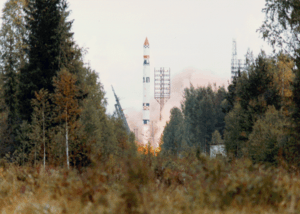Tsyklon-3
 A Tsyklon-3 launching a Meteor-3 satellite | |
| Function | Carrier rocket |
|---|---|
| Manufacturer | Yuzhmash |
| Country of origin | Soviet Union (Ukraine) |
| Size | |
| Height | 39.27 m (128.83 ft) |
| Diameter | 3 m (9.8 ft) |
| Mass | 189,000 kg (416,000 lb) |
| Stages | 3 |
| Capacity | |
| Payload to LEO | 4,100 kg (9,000 lb) |
| Associated rockets | |
| Family | R-36, Tsyklon |
| Derivatives | Tsyklon-4 |
| Comparable | Delta II |
| Launch history | |
| Status | Retired[1] |
| Launch sites | Plesetsk Cosmodrome LC-32 |
| Total launches | 122 |
| Successes | 114 |
| Failures | 8 |
| First flight | 24 June 1977 |
| Last flight | 30 January 2009[1] |
| Notable payloads |
Tselina Meteor Okean Geo-IK Strela |
| First stage – 11K69 | |
| Engines | 1 RD-261 |
| Thrust | 3,032 kN (681,620 lbf) |
| Specific impulse | 301 sec |
| Burn time | 120 seconds |
| Fuel | N2O4/UDMH |
| Second stage – 11S692 | |
| Engines | 1 RD-262 |
| Thrust | 941 kN (211,545 lbf) |
| Specific impulse | 318 sec |
| Burn time | 160 seconds |
| Fuel | N2O4/UDMH |
| Third stage – 11S693 | |
| Engines | 1 RD-861 |
| Thrust | 78.70 kN (17,694 lbf) |
| Specific impulse | 317 sec |
| Burn time | 125 seconds |
| Fuel | N2O4/UDMH |
The Tsyklon-3, also known as Tsiklon-3, GRAU index 11K68, was a Soviet, and subsequently Ukrainian orbital carrier rocket. A derivative of the R-36 ICBM, and a member of the Tsyklon family, it made its maiden flight on 24 June 1977, and was retired on 30 January 2009.[1] The Ukrainian-built Tsyklon rockets were retired in favour of future all-Russian carrier rockets, such as the Angara, and because they were fuelled by toxic hypergolic propellants.[2]
Successor
Ukraine is developing a commercial derivative of the Tsyklon-3, the Tsyklon-4.
2013 loss of Ecuadorian satellite after impact with Tsyklon-3 space debris
On 23 May 2013 at approximately 05:38 UTC, the Ecuadorian satellite NEE-01 Pegaso passed very close to the spent upper stage of a 1985 Tsyklon-3 rocket over the Indian Ocean. While there was no direct collision between the satellite and upper stage, Pegaso is believed to have suffered a "glancing blow" after passing through a debris cloud around the Tsyklon stage and striking one of the small pieces.[3][4] After the incident, the satellite was found to be "spinning wildly over two of its axes" and unable to communicate with its ground station.[3] Efforts to reestablish control of Pegaso failed,[4] and on 28 August 2013 the decision was made by EXA and the Ecuadorian government to declare the satellite as lost.[5]
See also
External links
References
- 1 2 3 Barbosa, Rui C. (2009-01-30). "Russian Tsyklon-3 bows out with CORONAS launch". NASASpaceflight.com. Retrieved 2009-01-30.
- ↑ APMC - Космические войска обеспечили реальность сроков сдачи в эксплуатацию перспективного РКК "Ангара" (Russian)
- 1 2 "Satellite collides with Soviet-era rocket". Al Jazeera. 24 May 2013. Archived from the original on 3 September 2013. Retrieved 13 September 2013.
- 1 2 "Ecuador tries to fix satellite after space debris crash". BBC News. 27 May 2013. Retrieved 14 September 2013.
- ↑ "Pegasus satellite was declared 'lost' by EXA". Ecuador Times. 5 September 2013. Archived from the original on 15 September 2013. Retrieved 14 September 2013.